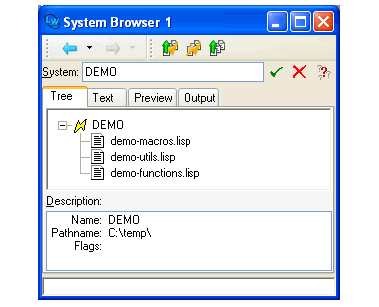






When you first invoke the System Browser, the Tree view is the default view. You can also switch to it from another view by choosing the relevant tab above the main view. The Tree view is shown in Displaying loaded systems using the Tree view below.
Figure 28.1 Displaying loaded systems using the Tree view


The System Browser window has four areas, described below.
The System area is used to enter and display in the name of the system.
You can browse a system by entering its name into the
System:
area. While doing this you can press Up, Down or click  to complete a partially specified name. This allows you to select from a list of all system names which begin with the partial input you have entered. See Completion for detailed instructions.
to complete a partially specified name. This allows you to select from a list of all system names which begin with the partial input you have entered. See Completion for detailed instructions.
The Tree area produces a tree of the current system, together with all its members. The generic facilities available to all tree views throughout the environment are available here; see Manipulating Graphs for details.
You can operate on systems and files via the context menu, which offers commands such as Concatenate... and Search Files... for systems, and Compile and Print... for files. The system commands are also available in the Works > Systems menu. If no items are selected, the commands apply to the current system, whose name is printed in the System area.
To traverse the system hierarchy, expand a system node in the tree. If the desired parent node is not in the tree, choose
Works > Systems > Browse All Systems
. The parent of all systems defined in the image at any time is called ALL-SYSTEMS.
To see the source code definition of a system, double-click its node in the tree or do
Works > Systems > Find Source
or click  .
.
The Description area shows details about any system member selected in the Tree area. The following items of information are shown:
The name of the selected member. This is either the filename (if the member is a file of source code) or the system name (if the member is a subsystem).
The directory pathname of the selected member. This is the full pathname of the file, if the selected member is a file of source code, or the default directory of the system, if the selected member is a subsystem.
This lists any keyword flags which have been set for the selected member in the system definition, such as the :source-only flag.
To operate on any of the items displayed in this area, select them and choose a command from the Works > Description menu, which contains the standard actions described in Performing operations on selected objects. By making multiple selections, you can operate on as many of the items as you like.
A variety of operations can be performed on any number of nodes selected in the Tree area. If no system nodes are selected, or if you are in another view, the commands are performed on the current system, whose name is printed in the System area.
The Works > Systems menu gives you access to the standard actions described in Performing operations on selected objects.
You need to save the buffers to actually save the changes on disk, this is easily done using the Editor tool - see Buffers area for details.
LispWorks IDE User Guide (Windows version) - 12 Feb 2015